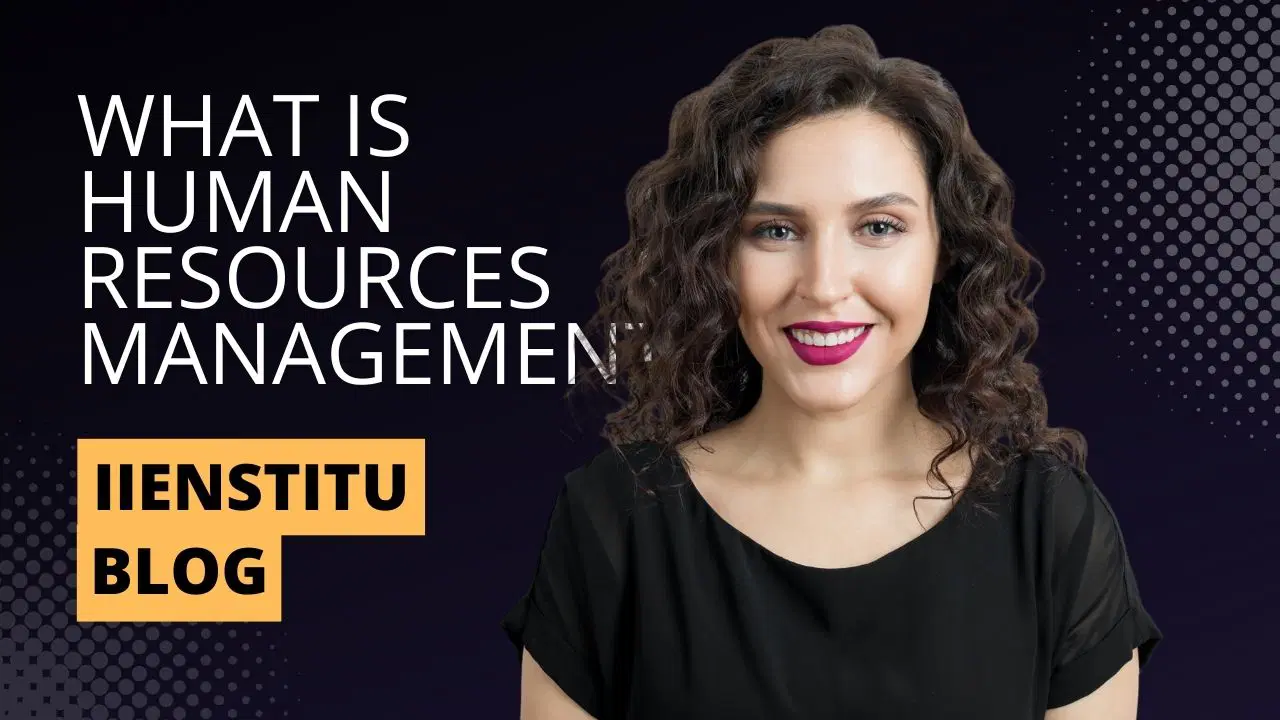
People often use human resource management (HRM) to describe the act of managing human resources. Or they'll equate human resources with human capital. However, human resources is a term that encompasses more than just the time an employee spends working for you or your organization.
Related Course: Hr Training
A human resource is any source of value to an individual or business. This can include anything from raw materials, supplies, contracts and services received through purchases; intellectual property; patents; copyrights; trademarks; employees who are paid by salary, wage or commission; interest groups like customers and suppliers; even potential customers. Essentially any stakeholder involved in the operations of your business could be considered part of your human resources because their needs affect how well your business runs.
What are Duties of Human Resources Management?
When you manage human resources, you're taking all of these things into account and trying to create a system that allocates them in the most effective way possible. This can include creating policies and procedures related to hiring, training, compensation, benefits, layoffs, and termination. It also includes developing strategies for attracting and retaining the best employees, as well as managing relationships with stakeholders.
Human resource management is a critical function in any organization. It helps ensure that your business has the people it needs to achieve its goals while also complying with all applicable laws and regulations. By taking a strategic approach to human resources management, you can improve employee productivity, reduce costs, and build a more successful company.
When done effectively, human resource management can be an incredibly valuable component of any business. It provides a system for human resources so you can achieve your goals and improve employee productivity. When human resource management is done properly, it also ensures that the human resources you need to build and strengthen your company are brought in and developed into assets that drive success.
What is the Mean of Human Resources Management?
The term human resource management signifies the direction and scope within an organization where employees are recruited, selected, assigned, trained, compensated, deployed, rewarded and even dismissed as well as providing guidelines for both legal matters such as discrimination and compliance issues such as codes of conduct.
What is the Human Resources Department?
A human resource department (HR department) is typically responsible for overseeing human resources practices within a firm or organization (for example: recruitment & selection; training; salary; benefits; retirement; medical & dental care). In some cases, there may be a separate human resources division. Employees within human resources typically have a variety of backgrounds which can include:
human resources management
business administration
psychology
sociology
labour relations
industrial relations
marketing
accounting
The human resources department is responsible for ensuring that the organization complies with all applicable laws and regulations related to employment. The human resources department also oversees employee files, such as job applications, performance reviews and disciplinary records. They may also be responsible for conducting exit interviews with departing employees.
What are Human Resources Management Responsibilities?
Human resource management (HRM) refers to the process of managing people in an organization. It encompasses everything from attracting and recruiting employees to ensuring that they are productive and satisfied in their jobs. HRM also includes issues such as compensation, benefits, training and development, and managing employee relations.
There are several key goals of human resource management:
- Attracting and retaining the best employees
- Ensuring that employees are productive and effective
- Maintaining a legally compliant workplace
- Reducing costs associated with employee turnover
- Developing a positive company culture
Attracting and retaining the best employees is essential for any organization. The human resources department is responsible for creating a system that identifies the best candidates and attracts them to the organization. They also need to develop a system for retaining employees by providing incentives such as competitive pay and benefits, job satisfaction, and a positive company culture.
Employees need to be productive and effective in order to help the organization achieve its goals. The human resources department is responsible for creating a system that evaluates employee productivity and provides training and development programs to help them improve. They also need to ensure that employees are aware of their job responsibilities and have the tools they need to do their jobs effectively.
Maintaining a legally compliant workplace is essential for any business. The human resources department is responsible for creating policies and procedures that comply with all applicable laws and regulations. They also need to ensure that employees are aware of their rights and responsibilities, and that managers are properly trained to handle HR issues.
Reducing costs associated with employee turnover is another way human resources can add value for an organization. The human resources department oversees the compensation and benefits system, which includes salaries, bonuses, 401(k) plans, stock options and paid time off. They also identify cost-saving opportunities by identifying workforce trends and providing training to managers on how they can retain employees.
Developing a positive company culture is important for any business. A company's corporate social responsibility program helps human resources support this goal by encouraging employees to be involved in their community and contribute to meaningful causes. In addition, organized volunteer programs help human resources build relationships with community organizations that may benefit from the skills of current employees or provide talent for future positions within the organization
Human resource management is responsible for human resource management. It aims at attracting and retaining the best employees, making sure that they are productive and efficient, maintaining a legally compliant workplace, reducing costs associated with human turnover, developing a positive company culture
Human Resources Management and Industrial Relations
Industrial relations is human resource management which has to do with human resources in industry. These include personnel who work across many different areas of business. Some commonly overseen positions include engineers, technicians, construction workers and other skilled labor positions. The human resource department oversees all human-related concerns within an organization. The human resource department should make sure any human-based changes implemented by the organization comply with all applicable labor laws. Among these changes may be hiring new employees, firing current ones or relocating entire departments to other buildings for ease of function. The human resources department should also keep records of employee job titles, contact information, pay grades and any benefits they are privy to.
Human Resources Management and Organizational Development
Organizational development is another key area of human resource management. OD deals with the overall health and well-being of the company as a whole. Through strategic planning, human resources can help align the company's goals with employee goals in order to create a more cohesive workforce. Additionally, human resources oversees training and development programs in order to equip employees with the tools they need to be successful. HR professionals should also analyze what motivates employees and work to create an environment where employees feel appreciated and challenged.
Human Resources Management and Benefits Administration
Benefits administration is another important facet of human resource management. By working with insurance providers, human resources can help design a benefits package that meets the needs of employees and the company. However, human resources should also work to prevent fraud by monitoring employee hires for relatives who are not eligible for benefits
Human Resources Management and Performance Management
Performance management talks about human resource having an active role in performance evaluation. The human resource department analyzes data on all aspects of organizational performance, looking for strengths and weaknesses or deviations from norms. They then relay this information to managers within the organization via formal performance reviews, development plans and recommendations for salary increases
Human Resources Management and Talent Management
Talent management is another aspect of human resource management. There are two types of talent management: "attraction" and "retention". Attraction deals with recruitment strategies while retention covers policies related to keeping current employees happy and productive. The human resources department is responsible for developing and executing both of these plans by working with managers and other team members to identify the skills and traits needed for success in specific positions. They then develop strategies to find employees with those qualities, as well as design retention policies that will keep them from leaving
Human Resources Management and Employees
Employee relations is the process of human resource management whereby employees are managed. Employee relations can be divided into two types: unionized and non-unionized workforces. In a unionized workforce, human resources must deal with the demands of the union representatives in order to ensure that all workers are treated fairly. Non-unionized workforces are less demanding, but human resources must still be careful to avoid any illegal discrimination or harassment in the workplace. Additionally, human resources must ensure that employees are aware of their rights and responsibilities
There are many other aspects of human resource management, such as worker's compensation, safety and health, and diversity and inclusion. However, the ones listed above are some of the most important. By understanding human resource management, employers can create a more effective and efficient workforce that is in compliance with all applicable laws.
What is the Purpose of Human Resources Management?
Human Resource Management (HRM) is the process by which an organization deals with the people who work for it. It encompasses everything from hiring new employees to firing current ones to ensuring that all workers are treated fairly. The human resources department is responsible for developing and executing policies related employee relations, organizational development, benefits administration, human capital management, compensation and rewards, performance management, benefits administration, human resources development and training.
Background information on human resource management
human resources management is an umbrella term that refers to the policies that human resource professionals put in place in order to help their organizations manage human capital effectively. human resources managers are responsible for recruiting new workers—usually with the support of HR recruiters—training current staff members and planning for anticipated changes within the organization. They may also be tasked with implementing organizational policies related to employee relations or benefits administration. human resources can help companies identify how profitability is affected by human-related issues such as turnover rates, absenteeism, motivation levels and customer satisfaction scores.
The human resources department typically analyzes an organizational performance, looking for strengths and weaknesses or deviations from norms. They then relay this information to managers within the organization via formal performance reviews, development plans and recommendations for salary increases.
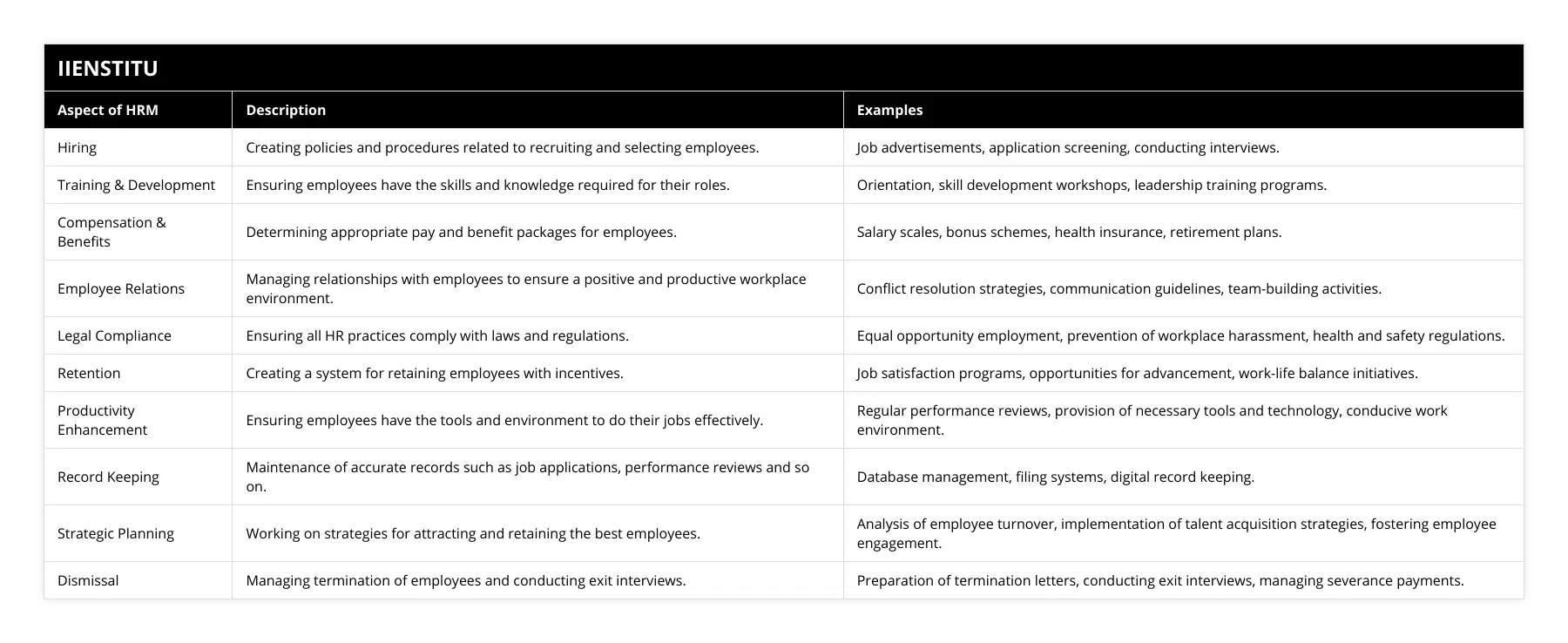
Frequently Asked Questions
What is the main purpose of Human Resource Management?
Main Purpose of HRM
The main purpose of Human Resource Management (HRM) is to optimize the performance of employees in order to achieve the strategic goals of an organization. This requires HRM to effectively manage all aspects of the employee lifecycle, from recruitment and training to performance evaluation, remuneration, and even employee separation.
Recruitment and Selection
A key function of HRM is to recruit and select the right individuals for the organization. This involves understanding the organization's needs, defining job requirements, attracting suitable candidates, and selecting the most fitting employees to fulfill specific roles.
Employee Training and Development
Another essential responsibility of HRM is to ensure the ongoing development of employees' skills and competencies. This is achieved through various training and development programs, enabling personnel to enhance their knowledge and abilities, become more efficient, and contribute positively to the organization's overall performance.
Performance Management
An important aspect of HRM is measuring and evaluating employee performance to ensure alignment with organizational objectives. This involves setting clear and measurable goals, conducting regular performance reviews, and providing constructive feedback to help employees improve and grow within their respective roles.
Compensation and Benefits
An effective HRM system is crucial in determining a fair and competitive compensation package for employees. This includes designing attractive salary structures, benefit schemes, and incentives that not only reward employees for their contributions but also motivate them to strive for excellence.
Employee Relations
HRM is responsible for fostering a positive working environment by managing employee relations. This includes resolving workplace conflicts, promoting diversity and inclusion, and facilitating open communication channels between employees and management.
Legal Compliance
Lastly, HRM plays a significant role in ensuring the organization adheres to various employment laws and regulations. This includes monitoring legal changes, implementing necessary policies and procedures, and safeguarding employee rights and interests to avoid potential legal disputes.
In conclusion, the main purpose of Human Resource Management is to maximize employee performance and well-being for the betterment of the organization. From recruiting top talent and providing growth opportunities to ensuring a positive work culture and legal compliance, a proficient HRM system is indispensable to an organization's overall success.
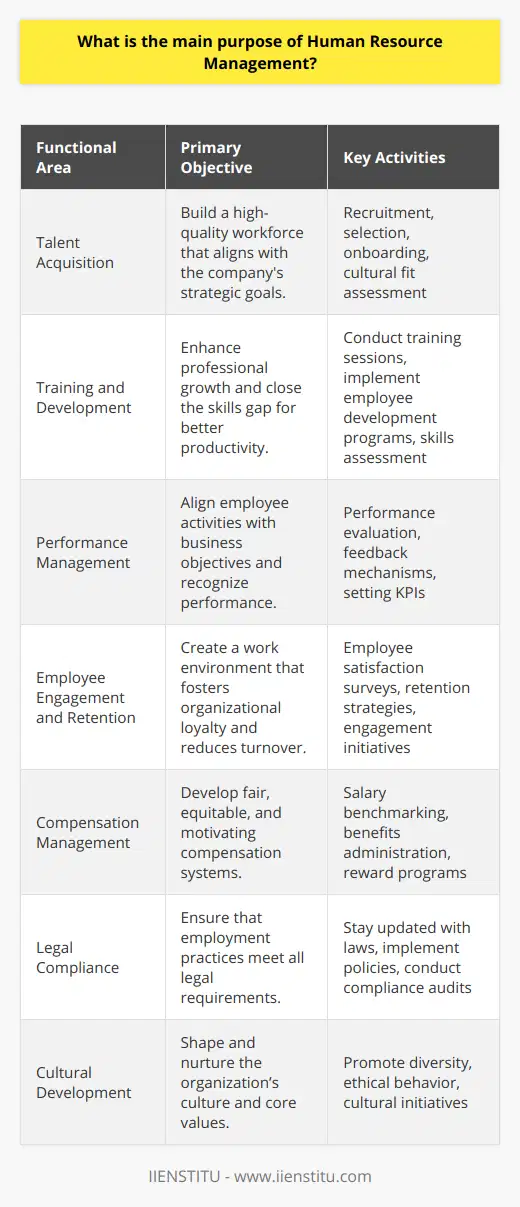
What are the 5 main areas of HR?
Human Resource Management: Key Functional Areas
**Recruitment and Selection**
One of the primary areas of human resource management (HRM) is recruitment and selection. It involves determining the human resource needs of an organization and finding the suitable candidates to best fill those positions. The HR department is responsible for advertising job vacancies, screening potential candidates, and conducting interviews to help the organization hire the right employees.
**Training and Development**
Another crucial area is training and development. This function includes the orientation of newly hired employees, as well as ongoing employee development programs. HRM aims to enhance employee skill sets through various training modalities, resulting in increased job performance, job satisfaction, and ultimately, employee retention.
**Performance Management**
Performance management is another cornerstone of HRM. It involves setting clear expectations for employees through the establishment of goals and the regular review of individual performance against these objectives. This process includes regular monitoring, employee reviews, and the provision of feedback on employees' performance to ensure continuous improvement and overall organizational effectiveness.
**Compensation and Benefits**
The fourth essential area of HRM is compensation and benefits administration. This aspect of HR involves developing, implementing, and managing remuneration strategies to attract, motivate, and retain employees. Compensation and benefits packages typically include salary, bonuses, and various non-monetary incentives such as health insurance or retirement funds, ensuring employees feel valued and fairly compensated for their efforts.
**Employee Relations and Engagement**
Lastly, employee relations and engagement is an essential area of HRM. This focuses on fostering a positive work environment and maintaining open lines of communication between employees and management. Effective employee engagement strategies can directly impact employee satisfaction, retention, and productivity. The HR department is responsible for addressing workplace grievances, implementing employee recognition programs, and promoting a collaborative and inclusive organizational culture.
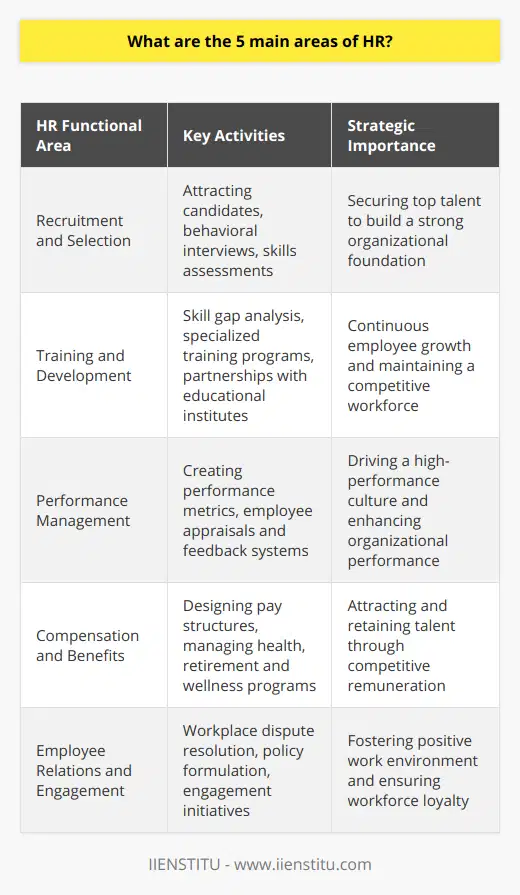
What is the simple definition of HR?
Understanding HR
In the corporate world, Human Resources (HR) represents a critically important department that deals with a company's most valuable asset – its workforce. Essentially, HR can be defined as the sector responsible for recruiting, retaining, and managing personnel.
Primary Functions of HR
HR serves several primary functions such as talent recruitment, employee onboarding, training and development, performance management, and benefits administration. By carrying out these responsibilities, HR professionals contribute significantly to creating a cohesive, productive, and engaged working environment.
Exceptional Talent Acquisition
One of the key roles of HR is identifying, attracting, and acquiring top talent to fulfill the organization’s requirements. This process involves evaluating the individual's skill set, experience, and cultural fit within the company, ultimately aiming to add value and growth to the organization.
Effective Employee Onboarding
Once candidates are selected, HR manages the employee onboarding process, ensuring a smooth transition into their new roles. This encompasses introduction to the workplace norms, culture, and behavioral expectations, as well as providing necessary tools and resources to be successful in their positions.
Promotion of Professional Development
Offering training and development opportunities to employees is another essential role of HR. By providing continuous learning and professional growth options, HR enables personnel to improve their skills and align them with the organization's overall goals.
Regular Performance Evaluation
HR continually engages in performance management, a systematic process that sets clear expectations for employees to strive towards. HR collaborates with managers and employees to establish performance objectives, provide constructive feedback, and identify additional training needs.
Comprehensive Benefits Administration
Lastly, HR is responsible for administering employee benefits, including health insurance, retirement plans, and paid time off. By effectively managing these benefits, HR not only follows legal requirements but also enhances employee satisfaction and retention.
In summary, the simple definition of HR encompasses a range of functions aimed at managing an organization's personnel, from talent acquisition to their professional development and wellbeing. By enhancing workforce cohesion and productivity, HR helps to drive growth and success within the organization.
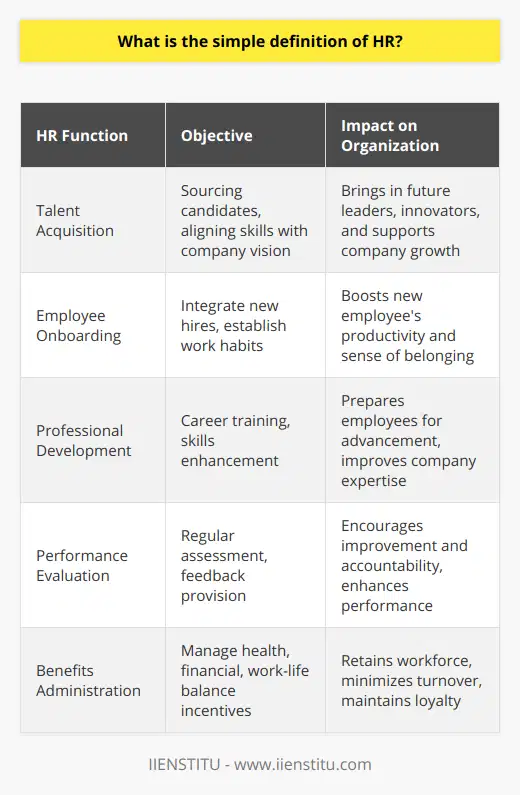
What are the core functions and objectives of human resource management?
Core Functions of HRM
The core functions of human resource management (HRM) are vital in fostering efficiency in an organization. HRM is responsible for staff recruitment, ensuring the organization attracts and retains top talent needed for its success. This involves preparing job descriptions, advertising job vacancies, screening and selecting candidates, and onboarding new hires.
Training and Development
Another essential function of HRM is to provide training and development opportunities for employees. This helps ensure workers have the skills and knowledge necessary to meet organizational objectives and adapt to changing market conditions. HRM designs and implements training programs, identifies skill gaps, and provides resources for continuous improvement and growth.
Performance Management
HRM plays a crucial role in performance management, continually reviewing and evaluating employee performance. This process includes setting performance goals, conducting performance appraisals, and providing feedback to employees. HRM aims to motivate and support employees to achieve their full potential, ultimately benefiting the overall organization.
Maintaining Compliance
HRM ensures that organizations remain compliant with labor laws and regulations, minimizing potential legal risks. HRM professionals stay informed of the latest changes in employment and labor laws, and implement any necessary changes within the organization. They also manage employee relations and address any disputes or grievances fairly and consistently in compliance with the law.
Promoting Employee Well-being
One of the primary objectives of HRM is to create a positive and supportive work environment, contributing to employee well-being and job satisfaction. This includes implementing employee safety programs, providing health and wellness initiatives, and offering compensation and benefits packages that meet employee needs. Additionally, HRM constructs policies and guidelines that promote diversity, inclusion, and equality within the workplace.
In conclusion, the core functions and objectives of human resource management play a pivotal role in ensuring the success of an organization. By effectively managing recruitment, training, performance, compliance, and well-being, HRM professionals contribute to individual employee growth and organizational productivity.
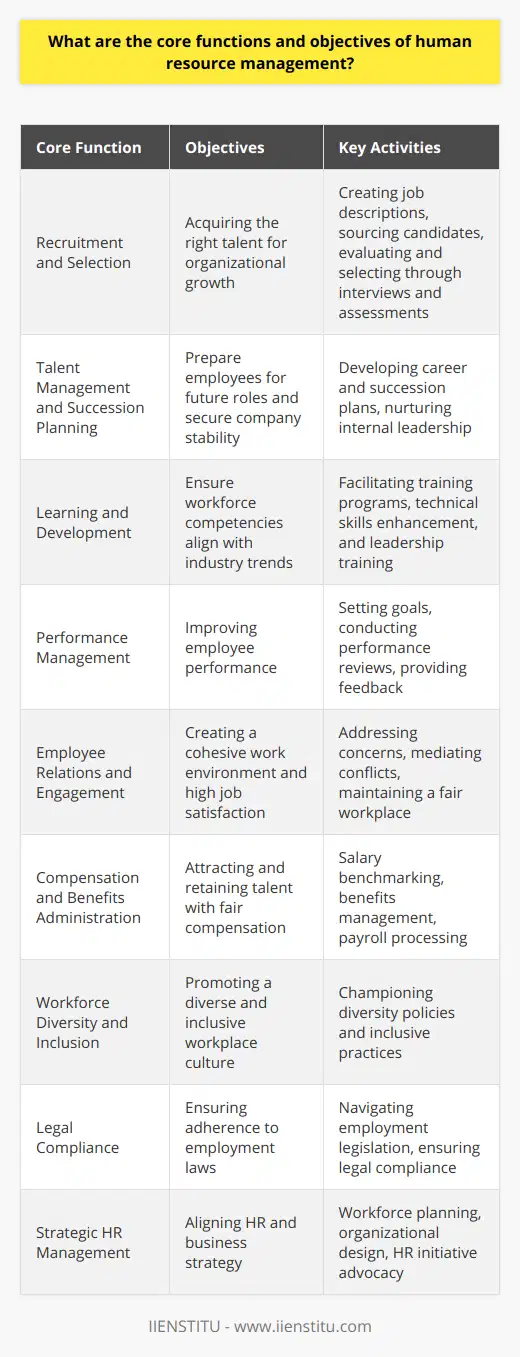
In what ways does the role of HR contribute to the overall success of an organization?
Critical Functions of HR in Organizational Success
Recruitment and Retention
HR plays a crucial role in recruiting and retaining the right talents for an organization. By continuously improving selection processes and developing effective retention strategies, HR not only ensures the organization has the right workforce but also minimizes turnover costs.
Employee Development and Training
HR aids employee development through designing and implementing regular training and development programs. By equipping employees with the essential skills, HR not only enables them to contribute effectively but also fosters a culture of continuous learning and adaptability within the organization.
Employee Relations and Policies
By managing employee relations, HR prevents potential conflicts and effectively addresses any grievances that may arise. Furthermore, by developing and enforcing employee policies in line with laws and regulations, HR ensures a fair and inclusive work environment, ultimately contributing to employee satisfaction and improved organizational outcomes.
Performance Management and Reward Systems
HR drives organizational success by creating performance appraisal systems that encourage employees to achieve their goals and contribute to business objectives. Additionally, HR designs reward systems that recognize employee accomplishments, ensuring continued motivation and fostering a performance-driven culture.
Organizational Change and Culture
HR supports organizational growth by facilitating change management and nurturing a positive work culture. By understanding and aligning employee expectations, HR can help drive transformation initiatives and guide the organization towards long-term success.
Strategic Planning and Business Alignment
As a strategic partner, HR serves as a critical link between the organization's purpose and its human capital requirements. By aligning workforce planning to the organization's strategic priorities, HR ensures that businesses have the resources needed to achieve their objectives and maintain a competitive edge.
In conclusion, the role of HR is instrumental in shaping the overall success of organizations in various ways. From recruitment and retention to strategic planning and alignment, HR contributes to numerous factors that profoundly impact the growth of an organization. By adopting a proactive and strategic approach, HR professionals can effectively support and optimize the outcomes on which the success of an organization is built.

How do human resource managers navigate the various challenges in the modern workplace?
Addressing Workforce Diversity
One of the primary challenges HR managers face is addressing and managing workforce diversity. As the modern workplace becomes increasingly global and multicultural, it is vital for HR managers to develop policies and practices that promote understanding and collaboration among employees from diverse backgrounds. They must ensure that all employees feel valued and included, which can lead to improved job satisfaction, higher retention rates, and increased productivity.
Adapting to Technological Advances
Another challenge HR managers face is adapting to rapid technological change. They must stay updated on the latest tools, technologies, and platforms that can improve performance management and training processes, enable remote work and communication, and streamline recruitment processes. HR managers should invest in learning about various HR technology tools and implement them in their organizations to ensure that they can effectively support their employees' needs and improve business performance.
Maintaining Compliance with Employment Laws
HR managers must also navigate the complexities of employment laws and regulations. They need to ensure that their organizations remain compliant with local, national, and international laws related to hiring practices, workplace safety, employee rights, and compensation. This task involves staying updated on new and changing regulations, communicating necessary changes to employees, and conducting regular audits and assessments to ensure compliance.
Addressing Mental Health and Well-being
The mental health and well-being of employees is another important challenge HR managers face in modern workplaces. HR managers must acknowledge the significance of mental health and foster a supportive workplace culture. They can achieve this by providing resources and programs that encourage employees to prioritize their mental health and well-being, such as offering access to mental health professionals, integrating mindfulness practices, and promoting work-life balance.
Managing Remote Workforces
With the rise of remote work, HR managers are tasked with managing and supporting employees working from different locations. To navigate this challenge, HR managers must develop robust policies and procedures that enable effective communication, collaboration, and performance management for remote employees. Additionally, they should consider offering training and development programs that enhance remote work skills, ensuring that employees are equipped to face unique challenges related to working remotely.
In conclusion, HR managers face numerous challenges in the modern workplace, including addressing workforce diversity, embracing technological advancements, maintaining compliance with employment laws, addressing mental health, and managing remote workforces. To navigate these challenges successfully, HR managers must be proactive in learning, adapting, and implementing new strategies, policies, and technologies that can improve the workplace experience for all employees.

What is Human Resource Management in simple terms?
Defining Human Resource Management
Human Resource Management (HRM) is an essential function within organizations, responsible for managing personnel and optimizing their contributions to the overall success of the company. In simpler terms, HRM is the art of managing human resources in a manner that maximizes their potential and enables organizations to achieve their goals.
Roles and Responsibilities
The primary objective of HRM is to ensure that organizations acquire, develop, and retain the best talents needed to remain competitive in their respective industries. To achieve this, HR managers perform various tasks, which often encompass workforce planning, recruitment, training and development, performance management, and employee relations. Furthermore, HRM also deals with compensation and benefits, labor relations, and legal compliance, aiming to provide a safe and equitable work environment for individuals.
Strategic Partnership
Nowadays, HRM is increasingly considered a strategic partner, playing a crucial role in shaping organizational policies and practices. It helps leaders align business goals with employees' needs and expectations, fostering an environment conducive to innovation, collaboration, and job satisfaction. As a critical connector between the organization's management and workforce, HRM plays a vital role in promoting a positive organizational culture and sustaining long-term success.
In conclusion, Human Resource Management, in simple terms, refers to the effective management of an organization's employees by adopting policies and practices that facilitate workforce planning, recruitment, training and development, performance management, and employee relations. Through these efforts, HRM contributes to creating a positive work environment that maximizes employees' potential, ultimately resulting in the organization's success.

What does HR management do?
HR Management Functions
Human Resource (HR) management plays a vital role in an organization, ensuring efficient utilization of its workforce. It encompasses many functions, from hiring to employee development and aligning the workforce with the company's strategic goals.
Recruitment and Selection
HR management begins with recruitment and selection, attracting qualified candidates and selecting suitable employees for vacancies. This process entails advertising job openings, screening applicants, conducting interviews, and ultimately making hiring decisions.
Training and Development
HR professionals also focus on employee training and development, preparing employees to meet current and future job requirements. They design and implement training programs, enabling workforce skill enhancement, and ensuring employees possess the necessary knowledge to excel in their roles.
Performance Management
To maintain productivity and keep employees motivated, HR managers track and assess individual performance. They establish criteria for appraisal, providing regular feedback, and addressing performance-related concerns. By identifying employees' strengths and areas needing improvement, HR managers facilitate growth and continuous development.
Compensation and Benefits
HR management plays a vital role in creating competitive compensation and benefits packages, attracting and retaining top talent. By researching market trends, HR professionals ensure that employees receive fair wages, adequate benefits, and incentives according to company policy and industry standards.
Compliance and Legal Issues
A critical aspect of HR management is ensuring the organization complies with labor laws and regulations. In protecting employees' rights, HR managers advise employers, create policies following legal requirements, and handle disputes or grievances when they arise.
Employee Relations
Maintaining positive employee relations is vital for a harmonious work environment. HR managers act as mediators between employees and employers, addressing grievances and resolving conflicts. Their role involves fostering open communication, listening to concerns, and establishing trustworthy relationships with employees.
Organizational Culture and Change Management
HR professionals contribute to shaping an organization's culture, creating an environment that fosters commitment, productivity, and job satisfaction. They manage change initiatives effectively by providing resources and support, ensuring a smooth transition, and minimizing disruptions or resistance.
In conclusion, Human Resource management is indispensable in sustaining an organization's success, contributing significantly to employee satisfaction, productivity, and overall growth. HR professionals oversee diverse functions, ultimately ensuring the effective management of human capital.

What are the 7 HR functions?
Key Human Resource Functions
An organization's success depends on the effective management of its human resources. There are seven key functions of human resources (HR) that play a critical role in achieving this goal.
Recruitment and Selection
This function involves attracting qualified candidates, reviewing their applications, conducting interviews, and selecting the best-suited individuals for open positions. Through effective recruitment and selection, HR ensures that the organization is staffed with the right mix of skills and expertise.
Training and Development
HR develops and implements training programs to enhance the skills and knowledge of employees. These programs may include onboarding, orientation, and ongoing training to ensure that employees are continually developing their skills and remain engaged in their roles.
Performance Management
This function seeks to ensure that employees' performance aligns with organizational goals. HR establishes performance evaluation systems, conducts regular performance reviews, and provides feedback to employees. These processes can also identify areas for improvement and support opportunities for professional growth.
Compensation and Benefits
HR manages compensation structures, such as salaries, bonuses, and merit increases, and ensures they are competitive with the labor market. Additionally, they design and administer benefit programs, including health insurance, retirement plans, and paid time off, to attract and retain employees.
Employee Relations
This function addresses the relationship between employees and the organization. HR facilitates clear communication, ensures compliance with employment laws, resolves conflicts, and fosters a positive working environment. This includes mediation, disciplinary measures, and grievance procedures.
Compliance and Risk Management
HR plays a crucial role in ensuring that an organization complies with relevant laws and regulations regarding employment practices. They develop and maintain policies, monitor organizational practices, and handle legal issues that may arise. Risk management involves working proactively to prevent potential liabilities.
Organizational Development
This function focuses on ensuring that the organization's structure, culture, and processes support its strategic goals. HR helps to develop organizational change initiatives, designs systems to increase efficiency, and promotes a culture that aligns with the organization's values and objectives.
In conclusion, the seven key functions of human resources are essential for an organization's success. Each function contributes to attracting, retaining, and engaging employees who will support the organization's strategies and contribute to achieving its objectives. By understanding these functions, HR professionals and organizational leaders can create a high-performing workforce that drives organizational excellence.



